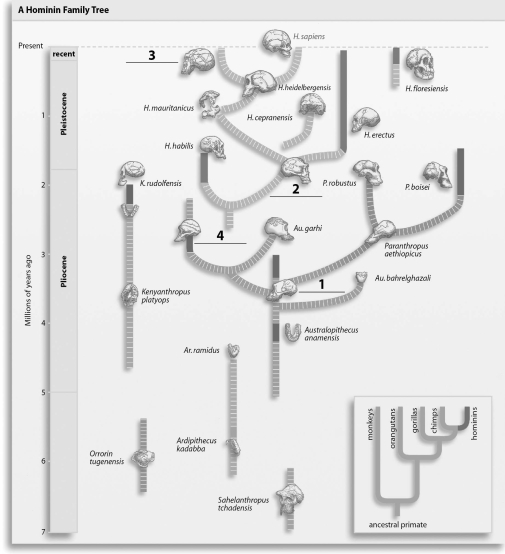Correct Answer

verified
Humans possess several features that are...View Answer
Show Answer
Correct Answer
verified
View Answer
Multiple Choice
According to the primate family tree,the modern species most closely related to the humans is the:
A) chimpanzee.
B) orangutan.
C) gorilla.
D) lemur.
Correct Answer

verified
Correct Answer
verified
Multiple Choice
A piece of evidence in favor of including Sahelanthropus tchadensis (Toumai) with the hominins rather than apes is that the species was likely:
A) tree dwelling.
B) bipedal.
C) related to Neanderthals.
D) carnivorous.
Correct Answer

verified
Correct Answer
verified
Multiple Choice
Which of the following is least important in deciding whether a fossil should be classified as a hominin?
A) bipedalism
B) slope of the face
C) brain size
D) tooth structure
Correct Answer

verified
Correct Answer
verified
Multiple Choice
Which hominin may be a direct ancestor of our genus but had long arms,short legs,and grasping feet?
A) Homo erectus
B) Australopithecus afarensis
C) Homo neanderthalensis
D) Kenyanthropus platyops
Correct Answer

verified
Correct Answer
verified
Multiple Choice
A significant difference between Neanderthals and modern humans is that Neanderthals:
A) had smaller brains.
B) were taller.
C) were foragers, not "collectors."
D) used throwing spears.
Correct Answer

verified
Correct Answer
verified
Essay
As you know from having studied the scientific method,a hypothesis must be able to make predictions that can be proved or disproved.The "out-of-Africa" hypothesis is currently more widely accepted than the "multiregionalism" school of thought.Summarize the out-of-Africa hypothesis,and explain the genetic diversity evidence in its favor.
Correct Answer

verified
The out-of-Africa hypothesis states that...View Answer
Show Answer
Correct Answer
verified
View Answer
Multiple Choice
Homo floresiensis is a relatively new find of fossils from:
A) Africa.
B) Indonesia.
C) Australia.
D) Europe.
Correct Answer

verified
Correct Answer
verified
Multiple Choice
Based on evidence from "primate molecular clocks," a primate common ancestor of humans and chimpanzees existed about:
A) 3 million years ago.
B) 4-5 million years ago.
C) 6-7 million years ago.
D) 10 million years ago.
Correct Answer

verified
Correct Answer
verified
True/False
The genus Kenyanthropus appears to be the immediate ancestor of the genus Homo.
Correct Answer

verified
Correct Answer
verified
Multiple Choice
Refer to the figure below, and then answer the following question(s) .
 -The missing label indicated by a "1" in the figure should be:
-The missing label indicated by a "1" in the figure should be:
A) Australopithecus afarensis.
B) Australopithecus africanus.
C) Homo ergaster.
D) Homo neanderthalensis.
Correct Answer

verified
Correct Answer
verified
Multiple Choice
Modern humans have been in existence for approximately how many years?
A) 100,000
B) 200,000
C) 500,000
D) 1,000,000
Correct Answer

verified
Correct Answer
verified
Essay
The fossils of Australopithecines indicate that,even though they walked upright,their arms were longer than their legs,and their feet still contained a partially opposable big toe.What does this suggest to you about their habitat and lifestyle?
Correct Answer

verified
Bipedalism clearly suggests that they sp...View Answer
Show Answer
Correct Answer
verified
View Answer
Short Answer
The first wave of modern human migration out of Africa began about ________.
Correct Answer

verified
50,000-60,...View Answer
Show Answer
Correct Answer
verified
View Answer
Multiple Choice
Refer to the figure below, and then answer the following question(s) .
 -The missing label indicated by a "3" in the figure should be:
-The missing label indicated by a "3" in the figure should be:
A) Australopithecus afarensis.
B) Australopithecus africanus.
C) Homo ergaster.
D) Homo neanderthalensis.
Correct Answer

verified
Correct Answer
verified
Multiple Choice
Several lines of evidence,including fossils and a genetic analysis of different groups of modern humans,suggest that our species originated and spread out from:
A) north Africa.
B) east Africa.
C) central Europe.
D) India.
Correct Answer

verified
Correct Answer
verified
Showing 41 - 56 of 56
Related Exams